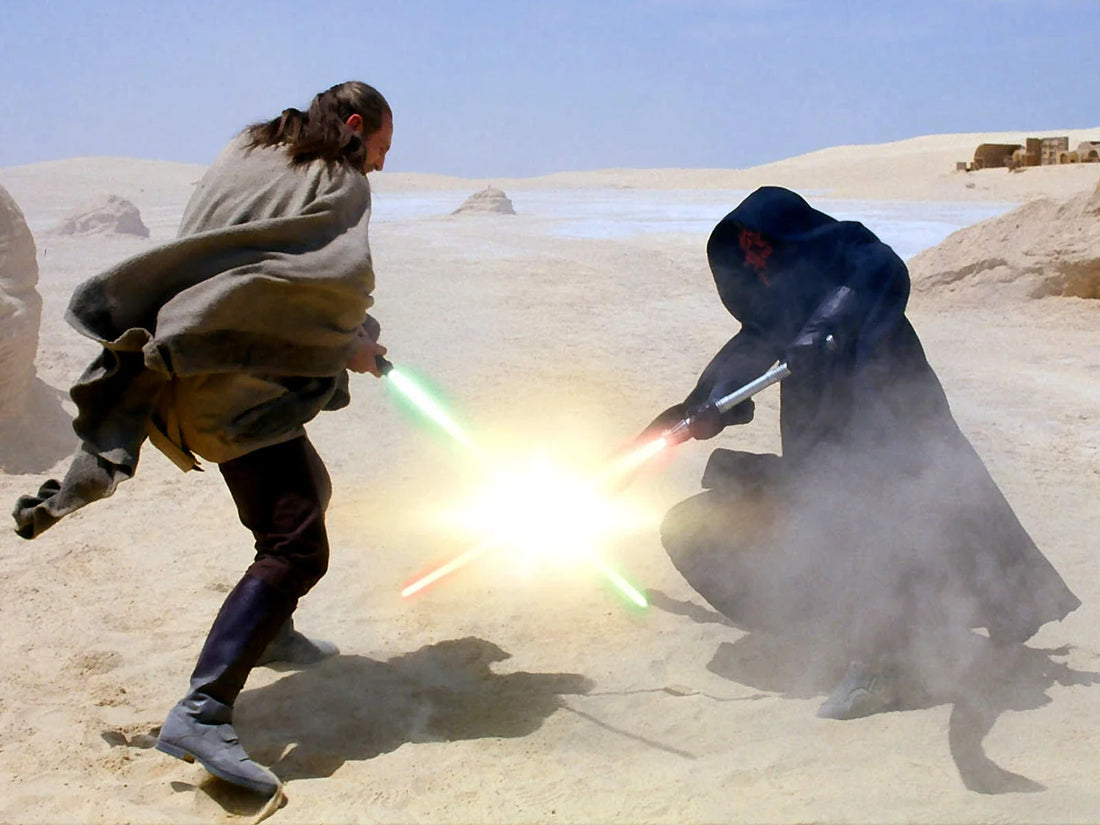Form I: Shii-Cho
Form I, also known as the determination form or "Way of the Sarlacc," was the earliest lightsaber combat form devised by the Jedi Council in response to the rising threats of Sith Lords. Named after the Sarlacc creature of Tatooine, it focused on basic offense and defense moves, akin to primitive metal swords. While effective initially, it faced challenges as Sith Lords adapted, necessitating the development of more advanced forms.
Initially, Shii-Cho proved successful in disarming opponents and maintaining Jedi superiority. However, as Sith Lords began mastering it and new threats emerged with projectile weapons, its limitations became evident. Despite its simplicity, skilled practitioners like Kit Fisto showcased its effectiveness in combat, notably during the Clone Wars.
Form II: Makashi
Form II, or Makashi, also known as the contention form or "Way of Ysalamiri," was developed to address the shortcomings of Shii-Cho in lightsaber duels. It emphasized precision and elegance, requiring extensive training. Makashi excelled in lightsaber-to-lightsaber combat but struggled against ranged attacks due to its focus on close combat.
Count Dooku, a skilled practitioner, demonstrated Makashi's effectiveness against opponents like Asajj Ventress and Obi-Wan Kenobi. Despite its limitations, Makashi remained a formidable form, particularly against Sith Lords.
Combat Form III: Soresu
Soresu, or the resilience form, also known as "The Way of the Mynock," was crafted to defend against ranged attacks, reflecting the Jedi Council's foresight in anticipating technological advancements. Masters of Soresu became nearly impervious to blaster fire, showcasing unmatched defensive capabilities.
While Soresu excelled defensively, its lack of offensive maneuvers left practitioners vulnerable in prolonged battles. Nevertheless, its mastery by Jedi like Obi-Wan Kenobi proved invaluable, especially during Order 66.
Combat Form IV: Ataru
Ataru, the aggression form or "Way of the Hawk-bat," represented a shift towards offensive tactics. Combining agility and Force abilities, Ataru practitioners overwhelmed opponents with rapid strikes while minimizing openings for counterattacks.
Although highly effective, Ataru required significant energy expenditure and left practitioners vulnerable to exhaustion and ranged attacks. Notable users like Qui-Gon Jinn and Obi-Wan Kenobi demonstrated its prowess against formidable adversaries.
Combat Form V: Shien & Djem
Form V, Shien & Djem, also known as the perseverance form or "The Way of Krayt Dragon," addressed the balance between offense and defense, refining techniques from previous forms. Shien focused on defensive maneuvers, redirecting blaster fire with precision, while Djem emphasized aggressive counterattacks.
Anakin Skywalker and Ahsoka Tano mastered Shien & Djem, showcasing its effectiveness in both defense and offense. Despite its versatility, the form had limitations against sustained ranged assaults.
Combat Form VI: Niman
Niman, the moderation form or "The Way of the Rancor," synthesized elements from previous forms, offering a balanced approach to combat. While lacking specialization, Niman provided versatility, allowing Jedi to adapt to various situations.
Grand Master Yoda and Obi-Wan Kenobi favored Niman for its adaptability and integration of Force abilities. Despite criticism for its lack of specialization, Niman remained a practical choice for Jedi diplomacy and combat readiness.
Combat Form VII: Juyo/Vaapad
Form VII, Juyo, or the ferocity form, was renowned for its aggressive and unpredictable attacks. However, its susceptibility to the dark side led to its ban by the Jedi Order. Mace Windu later reformed Juyo into Vaapad, emphasizing controlled emotions and utilizing negative energy without succumbing to the dark side.
Juyo/Vaapad practitioners like Mace Windu demonstrated unparalleled power and resilience in combat. Despite its risks, Vaapad offered a unique blend of physical and mental prowess, making it a formidable technique in the hands of a disciplined Jedi.
Conclusion
In summary, the seven forms of lightsaber combat embody diverse philosophies and techniques, reflecting the evolving nature of Jedi combat throughout the Star Wars saga. Each form offers unique strengths and limitations, catering to different fighting styles and tactical preferences. From the foundational principles of Shii-Cho to the refined techniques of Vaapad, lightsaber combat continues to be a central aspect of Jedi training and lore.




